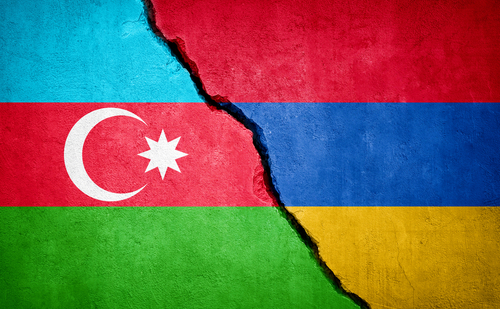By Davit Petrosyan
On 13 March 2025, Yerevan and Baku announced consensus on the peace agreement text, raising hopes of ending the decades-long conflict. The U.S. described it as a “historic peace treaty,” while the European Council encouraged both parties to proceed with signing. However, closer analysis suggests the document is more about formally closing the Nagorno-Karabakh conflict than achieving sustainable peace. The failure to resolve key disputes—such as unblocking regional transit routes and border delimitation—combined with growing military imbalance in Baku’s favor and Armenia’s concession of important deterrent tools, suggests that Azerbaijan may launch new escalations when the broader geopolitical climate becomes more permissive.

Photo source: ffikretow
BACKGROUND: The conflict between Armenia and Azerbaijan dates back to the late 1980s, when a war (1988-1994) broke out between ethnic Armenians in the Nagorno-Karabakh region—an autonomous oblast within the Azerbaijani Soviet Socialist Republic, predominantly inhabited by ethnic Armenians—and Azerbaijani forces. With backing from the Republic of Armenia, the Nagorno-Karabakh Armenians gained control not only over Nagorno-Karabakh but also seven adjacent districts. A ceasefire agreement brokered by Russia on 5 May 1994 effectively froze the conflict. Although Nagorno-Karabakh achieved de facto independence, it remained unrecognized by any country, including Armenia. The OSCE Minsk Group—co-chaired by Russia, the U.S., and France—was established to facilitate a peaceful resolution.
After sixteen years of stalled negotiations, the conflict reignited on 27 September 2020, when Azerbaijan—backed by Turkey—launched a large-scale offensive, reclaiming the seven surrounding districts and about a third of Nagorno-Karabakh. Following several failed mediation attempts by Russia, France, and the U.S., Russia brokered a ceasefire on 9 November 2020. The agreement commissioned the deployment of 2,000 Russian peacekeepers to the region; the establishment of a joint Russian-Turkish monitoring center; and the transferred control of the Lachin corridor, previously under Armenian control and connecting Armenia to Nagorno-Karabakh, to Russian peacekeeping forces.
In the following period, Yerevan and Baku engaged in several rounds of peace talks, initially mediated by Moscow. Over time, however, the EU and the U.S. assumed more active roles. Early negotiations focused on the status of Nagorno-Karabakh and later evolved into discussions about the rights and security of Armenians living in the former Nagorno-Karabakh Autonomous Oblast. Negotiations also centered on border delimitation, humanitarian issues including the return of prisoners of war and detainees, the handover of landmine maps, and the search for missing persons. A particularly contentious issue was the unblocking of regional transit routes (connectivity), including the so-called “Zangezur Corridor”, which would connect Azerbaijan to its western exclave, Nakhichevan.
Despite ongoing talks, Azerbaijan launched military incursions into Armenia’s internationally recognized territory between 2021 and 2022, occupying approximately 215 square kilometers. In response, Armenia invited the EU Mission in Armenia (EUMA) to monitor its border with Azerbaijan. In December 2022, Azerbaijan blockaded the Lachin corridor—with the tacit approval of Russian peacekeepers—and, following a ten-month blockade, launched an offensive that resulted in the forced displacement of 120,000 ethnic Armenians from the region.
Since then, peace talks have continued, with Armenia seeking to avoid further escalation and Azerbaijan advancing new demands. On 13 March 2025, both parties announced a consensus on the text of the peace agreement. However, Azerbaijan added two conditions: the “amendment” of Armenia’s Constitution and the dissolution the OSCE Minsk Group.
IMPLICATIONS: The agreement fails to resolve all disputes, leaving flashpoints that could trigger new escalations. One major issue is connectivity—the modalities for restoring road links, which is absent from the finalized text. Azerbaijan continues demanding unhindered access to its western exclave Nakhichevan, and has repeatedly threatened to open the so-called “Zangezur Corridor” by force. Conversely, Armenia views any extraterritorial corridor as a red line, signaling its resolve to respond proportionally. This marks a shift from earlier Azerbaijani incursions, when Armenian forces adopted a defensive posture, with Prime Minister Pashinyan declaring that Armenia would not retake occupied territories militarily.
The diverging stances of regional powers on connectivity could either deter or ignite a future conflict. On February 14, 2025, Russian Foreign Ministry spokeswoman Maria Zakharova blamed Armenia for “freezing” trilateral efforts to reopen routes. On March 26, 2025, Turkish President Erdoğan declared plans to build regional trade corridors centered on Zangezur. Conversely, on September 7, 2024, a senior Iranian official reaffirmed that the “Zangezur Corridor” was a red line for Iran. Joint Armenia-Iran military exercises in April 2025, amid increased Azerbaijani activity along the border, aimed to demonstrate Iran’s readiness to deter Azerbaijani attempts to take the route by force.
The agreement also leaves border delimitation unresolved, which has already led to military clashes, with Azerbaijan occupying 215 km² of Armenian territory. To date, only one portion of the border has been delimited. Key areas where Azerbaijani forces have advanced remain undelimited. Azerbaijan has shown no intention of withdrawing, raising doubts about the agreement’s ability to resolve tensions and establish lasting peace. Importantly, Russia can leverage disputes on this issue and connectivity to maintain its influence in the region.
The EUMA’s removal from the Armenian–Azerbaijani border would significantly weaken Armenia’s security. Since EUMA’s deployment in mid-February 2023, not a single square meter of Armenian territory has been occupied. The mission has served as an effective external balancing tool, deterring Azerbaijani advances. Given that large portions of the border remain undelimited, EUMA’s withdrawal would eliminate a key stabilizing presence and increase the risk of new Azerbaijani aggression.
Under the peace deal, Armenia agreed to withdraw international lawsuits against Azerbaijan, forfeiting another deterrent. Four applications to the European Court of Human Rights documented widespread Azerbaijani human rights violations during the Nagorno-Karabakh war, while Armenia's complaint to the International Court of Justice accused Azerbaijan of systematic racial discrimination. Dropping these cases not only erases the record of violations but also removes a major constraint on Azerbaijan’s future actions, freeing its hands for provocations.
The peace agreement lacks enforcement mechanisms. No third party is designated to oversee compliance, further increasing the risk of escalation. It also fails to address the fate of at least 106 Armenian prisoners of war (POWs) and detainees, making the document resemble a “punitive” conclusion to the war rather than a genuine peace agreement.
One of the primary motivations behind Azerbaijan’s additional conditions, “amending” Armenia’s Constitution and dissolving the Minsk Group, is to bury the Nagorno-Karabakh issue. The Constitution’s preamble cites the 1990 Declaration of Independence and references the joint statement of the Supreme Council of the Armenian SSR and the National Council of Nagorno-Karabakh. Azerbaijan portrays this as evidence of Armenian territorial claims. The dissolution of the Minsk Group is intended to symbolize the closure of the conflict it was created to resolve.
Finally, the military balance continues to shift in Azerbaijan’s favor. While both countries allocate 4–5 percent of their GDP to defense, Azerbaijan’s spending was 3.5 times higher in 2020, 4.4 times higher in 2021, 3.8 times higher in 2022, and 2.7 times higher in 2023. Projections show that Azerbaijan’s defense budget was 2.7 times higher in 2024 and is expected to be 2.9 times higher in 2025. As the imbalance grows, Azerbaijan’s confidence in resorting to force to compel Armenia into new concessions is likely to increase.
CONCLUSION: The current peace agreement fails to resolve crucial disputes between Armenia and Azerbaijan, depriving Armenia of important balancing and deterrent mechanisms. The two additional conditions put forward by Azerbaijan suggest that at this stage, Baku's aim is not to achieve a comprehensive peace, but to decisively close the Nagorno-Karabakh issue. The failure to address the issue of Armenian POWs and detainees held in Baku, as well as the rights of Nagorno-Karabakh Armenians, demonstrates that this agreement is not aimed at bringing sustainable peace to the South Caucasus but rather at formally confirming Azerbaijan's achievements so far.
The weak peace agreement and the continually shifting military balance in Azerbaijan's favor enables Baku to retain the necessary levers to escalate the situation when the geopolitical environment appears more favorable. It reserves options to compel Armenia into new concessions, such as securing the route to Nakhichevan on its own terms and constraining Armenia's post-conflict recovery efforts. Finally, diverging positions over the reopening of regional transit routes and conflicting interests among regional powers could serve as additional triggers for renewed escalation, providing Russia with opportunities to maintain its influence in the region.
AUTHOR BIO: Davit Petrosyan is a Fulbright Scholar pursuing a Master’s in International Affairs at the Bush School of Government and Public Service, Texas A&M University. Previously, he served as an Assistant to the Secretary of the Security Council of the Republic of Armenia and as Chief Program Officer of Restart Civic-Youth Foundation.



